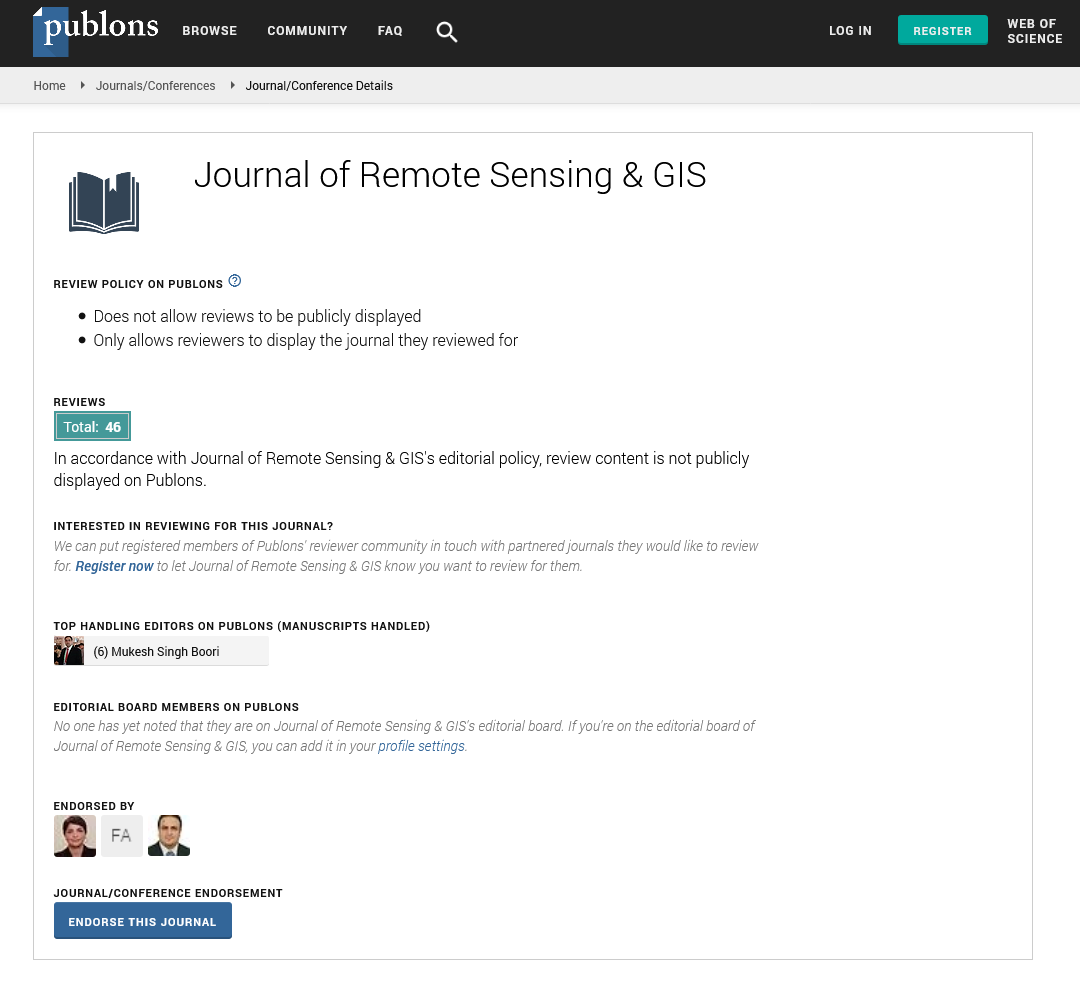Indexed In
- Open J Gate
- RefSeek
- Hamdard University
- EBSCO A-Z
- OCLC- WorldCat
- Publons
- International Scientific Indexing
- Euro Pub
- Google Scholar
Useful Links
Share This Page
Journal Flyer

Open Access Journals
- Agri and Aquaculture
- Biochemistry
- Bioinformatics & Systems Biology
- Business & Management
- Chemistry
- Clinical Sciences
- Engineering
- Food & Nutrition
- General Science
- Genetics & Molecular Biology
- Immunology & Microbiology
- Medical Sciences
- Neuroscience & Psychology
- Nursing & Health Care
- Pharmaceutical Sciences
Commentary - (2024) Volume 13, Issue 3
Technological Innovations in Wildlife Conservation through Remote Sensing and GIS
Nelson Richardson*Received: 26-Aug-2024, Manuscript No. JGRS-24-26969; Editor assigned: 29-Aug-2024, Pre QC No. JGRS-24-26969 (PQ); Reviewed: 13-Sep-2024, QC No. JGRS-24-26969; Revised: 20-Sep-2024, Manuscript No. JGRS-24-26969 (R); Published: 27-Sep-2024, DOI: 10.35248/2469-4134.24.13.351
Description
Wildlife habitat mapping and conservation have become important fields in ecology due to the rapid degradation of natural environments caused by human activities. Remote Sensing (RS) and Geographic Information Systems (GIS) provide powerful tools for monitoring, mapping and conserving wildlife habitats. With the growing threats of habitat loss, climate change and human encroachment, wildlife conservation efforts have become increasingly reliant on technological innovations. These tools allow researchers and conservationists to collect, analyze and visualize spatial data that provides insights into species distribution, habitat quality and the effects of environmental changes.
Wildlife habitat mapping involves the identification and delinea- tion of areas that provide necessary resources for the survival of species, such as food, shelter and breeding grounds. The application of RS and GIS in this domain enhances the ability to analyze large, inaccessible, or ecologically sensitive areas over time, enabling the development of efficient conservation plans.
Remote sensing in wildlife habitat mapping
Remote sensing involves collecting information about the earth's surface without direct contact, typically using satellites, drones, or aircraft. Various sensors on these platforms capture electromagnetic data that is processed to create detailed images and maps. The most commonly used remote sensing technologies in wildlife habitat mapping include:
Multispectral and hyperspectral imaging: These systems capture images in multiple spectral bands, which are useful for identifying vegetation types, water bodies and soil conditions key components of wildlife habitats.
LiDAR (Light Detection and Ranging): LiDAR technology uses laser pulses to create high-resolution topographic maps, which are important for understanding habitat structure and terrain.
Synthetic Aperture Radar (SAR): SAR uses radar waves to penetrate clouds and vegetation, providing data on forest density, terrain and land cover, even in adverse weather conditions.
Applications of remote sensing
Major applications of remote sensing are:
Vegetation and land cover classification: Remote sensing is widely used to map and classify vegetation, which serves as the foundation for wildlife habitats. By analyzing spectral signatures of different plant species and land cover types, researchers can assess the suitability of areas for specific wildlife species.
Habitat suitability and distribution modeling: Combining remote sensing data with species distribution models enables the prediction of suitable habitats. For instance, areas with a high density of specific vegetation types can be identified as potential habitats for herbivores.
Monitoring habitat changes: Remote sensing allows for continuous monitoring of habitat changes over time, which is essential for tracking the impact of deforestation, urbanization and climate change. Satellite imagery can highlight trends in habitat degradation or expansion, informing conservation interventions.
GIS in wildlife conservation
Geographic Information Systems (GIS) provide the ability to store, manage and analyze spatial and non-spatial data. In wildlife conservation, GIS is essential for visualizing and interpreting habitat data collected from remote sensing technologies. GIS integrates diverse datasets such as topography, vegetation, climate and species observations into a unified platform, facilitating spatial analysis and decision-making.
GIS applications in wildlife conservation
Major applications of GIS in wildlife conservation are:
Habitat mapping and zoning: GIS is a key tool for developing detailed maps of wildlife habitats and creating zoning plans for protected areas. For example, GIS can delineate core habitat areas, buffer zones and migration corridors, ensuring the protection of important wildlife populations.
Species Distribution Modeling (SDM): GIS allows conservationists to model species distributions by combining environmental variables such as temperature, elevation and precipitation with species occurrence data. This helps identify potential habitats and prioritize areas for conservation.
Migration and movement analysis: Tracking animal movements is important for understanding migration patterns and the use of different habitats. GIS can integrate GPS tracking data from collars or tags with landscape features, helping to identify migration corridors and seasonal habitats.
Risk assessment and threat mapping: GIS can be used to map potential threats to wildlife, such as poaching hotspots, urban expansion, or areas prone to wildfires. These threat maps inform conservation strategies by highlighting regions that require immediate intervention.
Conclusion
Remote sensing and GIS are indispensable tools for wildlife habitat mapping and conservation. Their ability to provide detailed, accurate and timely information about the environment allows conservationists to make informed decisions, protect endangered species and manage habitats more effectively. Continued advancements in technology and increased access to data will further strengthen the role of RS and GIS in global wildlife conservation efforts.
Citation: Richardson N (2024). Technological Innovations in Wildlife Conservation through Remote Sensing and GIS. J Remote Sens GIS. 13:351.
Copyright: © 2024 Richardson N. This is an open-access article distributed under the terms of the Creative Commons Attribution License, which permits unrestricted use, distribution and reproduction in any medium, provided the original author and source are credited.

